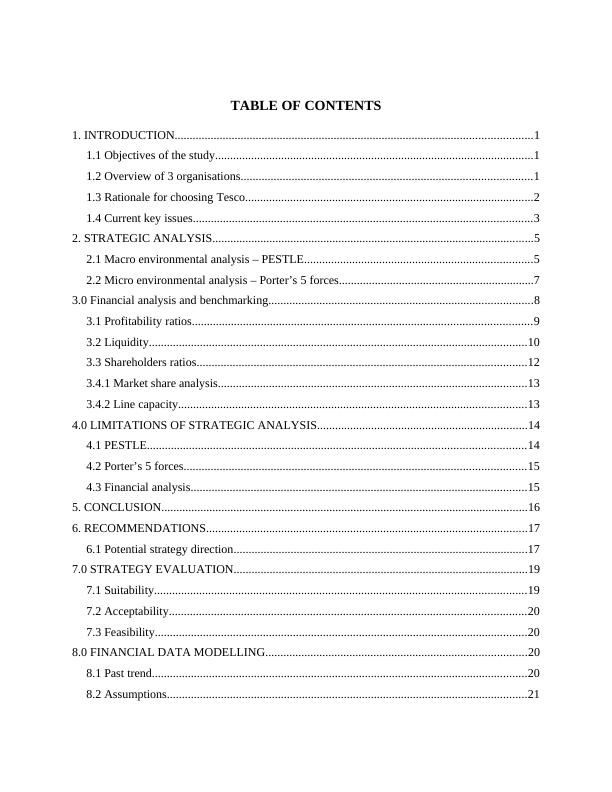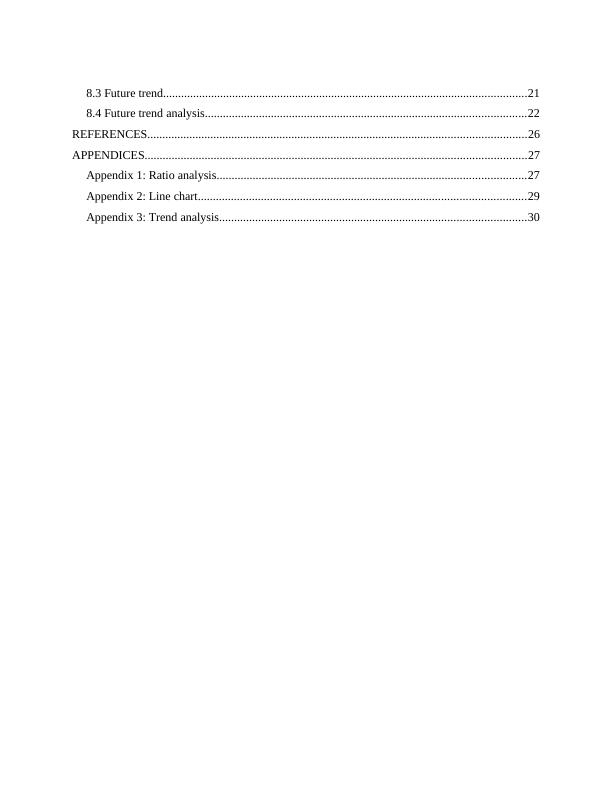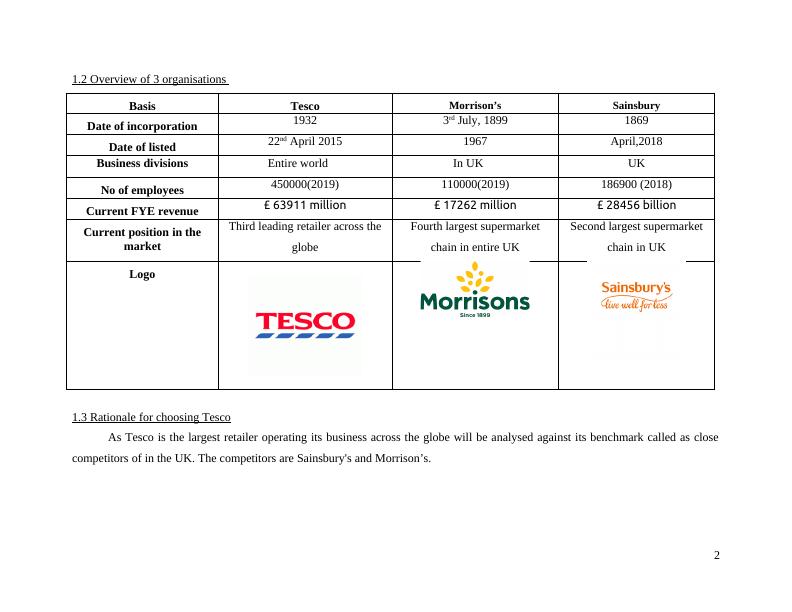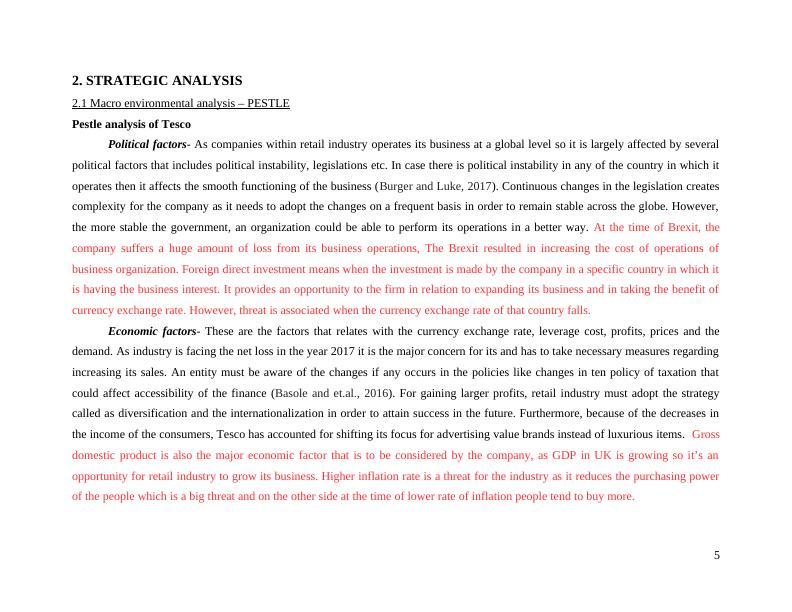Business Analysis of Tesco
Added on 2021-02-20
36 Pages5275 Words26 Views
BUSINESS ANALYSIS

TABLE OF CONTENTS
1. INTRODUCTION.......................................................................................................................1
1.1 Objectives of the study..........................................................................................................1
1.2 Overview of 3 organisations.................................................................................................1
1.3 Rationale for choosing Tesco................................................................................................2
1.4 Current key issues.................................................................................................................3
2. STRATEGIC ANALYSIS...........................................................................................................5
2.1 Macro environmental analysis – PESTLE............................................................................5
2.2 Micro environmental analysis – Porter’s 5 forces.................................................................7
3.0 Financial analysis and benchmarking........................................................................................8
3.1 Profitability ratios.................................................................................................................9
3.2 Liquidity..............................................................................................................................10
3.3 Shareholders ratios..............................................................................................................12
3.4.1 Market share analysis.......................................................................................................13
3.4.2 Line capacity....................................................................................................................13
4.0 LIMITATIONS OF STRATEGIC ANALYSIS......................................................................14
4.1 PESTLE..............................................................................................................................14
4.2 Porter’s 5 forces..................................................................................................................15
4.3 Financial analysis................................................................................................................15
5. CONCLUSION..........................................................................................................................16
6. RECOMMENDATIONS...........................................................................................................17
6.1 Potential strategy direction..................................................................................................17
7.0 STRATEGY EVALUATION..................................................................................................19
7.1 Suitability............................................................................................................................19
7.2 Acceptability.......................................................................................................................20
7.3 Feasibility............................................................................................................................20
8.0 FINANCIAL DATA MODELLING.......................................................................................20
8.1 Past trend.............................................................................................................................20
8.2 Assumptions........................................................................................................................21
1. INTRODUCTION.......................................................................................................................1
1.1 Objectives of the study..........................................................................................................1
1.2 Overview of 3 organisations.................................................................................................1
1.3 Rationale for choosing Tesco................................................................................................2
1.4 Current key issues.................................................................................................................3
2. STRATEGIC ANALYSIS...........................................................................................................5
2.1 Macro environmental analysis – PESTLE............................................................................5
2.2 Micro environmental analysis – Porter’s 5 forces.................................................................7
3.0 Financial analysis and benchmarking........................................................................................8
3.1 Profitability ratios.................................................................................................................9
3.2 Liquidity..............................................................................................................................10
3.3 Shareholders ratios..............................................................................................................12
3.4.1 Market share analysis.......................................................................................................13
3.4.2 Line capacity....................................................................................................................13
4.0 LIMITATIONS OF STRATEGIC ANALYSIS......................................................................14
4.1 PESTLE..............................................................................................................................14
4.2 Porter’s 5 forces..................................................................................................................15
4.3 Financial analysis................................................................................................................15
5. CONCLUSION..........................................................................................................................16
6. RECOMMENDATIONS...........................................................................................................17
6.1 Potential strategy direction..................................................................................................17
7.0 STRATEGY EVALUATION..................................................................................................19
7.1 Suitability............................................................................................................................19
7.2 Acceptability.......................................................................................................................20
7.3 Feasibility............................................................................................................................20
8.0 FINANCIAL DATA MODELLING.......................................................................................20
8.1 Past trend.............................................................................................................................20
8.2 Assumptions........................................................................................................................21

8.3 Future trend.........................................................................................................................21
8.4 Future trend analysis...........................................................................................................22
REFERENCES..............................................................................................................................26
APPENDICES...............................................................................................................................27
Appendix 1: Ratio analysis.......................................................................................................27
Appendix 2: Line chart.............................................................................................................29
Appendix 3: Trend analysis......................................................................................................30
8.4 Future trend analysis...........................................................................................................22
REFERENCES..............................................................................................................................26
APPENDICES...............................................................................................................................27
Appendix 1: Ratio analysis.......................................................................................................27
Appendix 2: Line chart.............................................................................................................29
Appendix 3: Trend analysis......................................................................................................30

1. INTRODUCTION
Business analysis is a process that is been adopted by the firm for enabling the change in an organization with defining the
needs and the recommending solutions which deliver the value to the stakeholders. It is the set of the tasks and the techniques that is
been used for performing the assessment of the financial and the operational activities of the business (Schaltegger, Lüdeke-Freund
and Hansen, 2016).
1.1 Objectives of the study
The report presents the analysis of the competitive position of Tesco against Sainsbury's and Morrison’s with appropriate
benchmark analysis. Furthermore, the study emphasizes on the comparative financial analysis in between the companies with the
application of the appropriate models that is pestle analysis. Moreover, the report also throws the deep insights towards the
disadvantages of the financial models with recommendations regarding where the company needs to make improvements.
1
Business analysis is a process that is been adopted by the firm for enabling the change in an organization with defining the
needs and the recommending solutions which deliver the value to the stakeholders. It is the set of the tasks and the techniques that is
been used for performing the assessment of the financial and the operational activities of the business (Schaltegger, Lüdeke-Freund
and Hansen, 2016).
1.1 Objectives of the study
The report presents the analysis of the competitive position of Tesco against Sainsbury's and Morrison’s with appropriate
benchmark analysis. Furthermore, the study emphasizes on the comparative financial analysis in between the companies with the
application of the appropriate models that is pestle analysis. Moreover, the report also throws the deep insights towards the
disadvantages of the financial models with recommendations regarding where the company needs to make improvements.
1

1.2 Overview of 3 organisations
Basis Tesco Morrison’s Sainsbury
Date of incorporation 1932 3rd July, 1899 1869
Date of listed 22nd April 2015 1967 April,2018
Business divisions Entire world In UK UK
No of employees 450000(2019) 110000(2019) 186900 (2018)
Current FYE revenue £ 63911 million £ 17262 million £ 28456 billion
Current position in the
market
Third leading retailer across the
globe
Fourth largest supermarket
chain in entire UK
Second largest supermarket
chain in UK
Logo
1.3 Rationale for choosing Tesco
As Tesco is the largest retailer operating its business across the globe will be analysed against its benchmark called as close
competitors of in the UK. The competitors are Sainsbury's and Morrison’s.
2
Basis Tesco Morrison’s Sainsbury
Date of incorporation 1932 3rd July, 1899 1869
Date of listed 22nd April 2015 1967 April,2018
Business divisions Entire world In UK UK
No of employees 450000(2019) 110000(2019) 186900 (2018)
Current FYE revenue £ 63911 million £ 17262 million £ 28456 billion
Current position in the
market
Third leading retailer across the
globe
Fourth largest supermarket
chain in entire UK
Second largest supermarket
chain in UK
Logo
1.3 Rationale for choosing Tesco
As Tesco is the largest retailer operating its business across the globe will be analysed against its benchmark called as close
competitors of in the UK. The competitors are Sainsbury's and Morrison’s.
2

1.4 Current key issues
Revenue of Tesco is decreasing over the years which means that company is not making effective marketing strategy in order
to meet its sales target. However, in the year 2017 the sales get increased from 54433 to 55917 because of the low prices and
facilitating quality products to its customers. Net profit of Tesco was resulted as negative which means a huge loss in the year 2017
because its interest expense increases and the cost of revenue also increases. It resulted as 138 to -40 which in turn hinders the growth
and reputation of the company. Profit before tax also get reduced in the year 2017 but increased with a greater amount in the year
2018 as the operating expense and the interest expense reduces.
3
Revenue of Tesco is decreasing over the years which means that company is not making effective marketing strategy in order
to meet its sales target. However, in the year 2017 the sales get increased from 54433 to 55917 because of the low prices and
facilitating quality products to its customers. Net profit of Tesco was resulted as negative which means a huge loss in the year 2017
because its interest expense increases and the cost of revenue also increases. It resulted as 138 to -40 which in turn hinders the growth
and reputation of the company. Profit before tax also get reduced in the year 2017 but increased with a greater amount in the year
2018 as the operating expense and the interest expense reduces.
3

4

2. STRATEGIC ANALYSIS
2.1 Macro environmental analysis – PESTLE
Pestle analysis of Tesco
Political factors- As companies within retail industry operates its business at a global level so it is largely affected by several
political factors that includes political instability, legislations etc. In case there is political instability in any of the country in which it
operates then it affects the smooth functioning of the business (Burger and Luke, 2017). Continuous changes in the legislation creates
complexity for the company as it needs to adopt the changes on a frequent basis in order to remain stable across the globe. However,
the more stable the government, an organization could be able to perform its operations in a better way. At the time of Brexit, the
company suffers a huge amount of loss from its business operations, The Brexit resulted in increasing the cost of operations of
business organization. Foreign direct investment means when the investment is made by the company in a specific country in which it
is having the business interest. It provides an opportunity to the firm in relation to expanding its business and in taking the benefit of
currency exchange rate. However, threat is associated when the currency exchange rate of that country falls.
Economic factors- These are the factors that relates with the currency exchange rate, leverage cost, profits, prices and the
demand. As industry is facing the net loss in the year 2017 it is the major concern for its and has to take necessary measures regarding
increasing its sales. An entity must be aware of the changes if any occurs in the policies like changes in ten policy of taxation that
could affect accessibility of the finance (Basole and et.al., 2016). For gaining larger profits, retail industry must adopt the strategy
called as diversification and the internationalization in order to attain success in the future. Furthermore, because of the decreases in
the income of the consumers, Tesco has accounted for shifting its focus for advertising value brands instead of luxurious items. Gross
domestic product is also the major economic factor that is to be considered by the company, as GDP in UK is growing so it’s an
opportunity for retail industry to grow its business. Higher inflation rate is a threat for the industry as it reduces the purchasing power
of the people which is a big threat and on the other side at the time of lower rate of inflation people tend to buy more.
5
2.1 Macro environmental analysis – PESTLE
Pestle analysis of Tesco
Political factors- As companies within retail industry operates its business at a global level so it is largely affected by several
political factors that includes political instability, legislations etc. In case there is political instability in any of the country in which it
operates then it affects the smooth functioning of the business (Burger and Luke, 2017). Continuous changes in the legislation creates
complexity for the company as it needs to adopt the changes on a frequent basis in order to remain stable across the globe. However,
the more stable the government, an organization could be able to perform its operations in a better way. At the time of Brexit, the
company suffers a huge amount of loss from its business operations, The Brexit resulted in increasing the cost of operations of
business organization. Foreign direct investment means when the investment is made by the company in a specific country in which it
is having the business interest. It provides an opportunity to the firm in relation to expanding its business and in taking the benefit of
currency exchange rate. However, threat is associated when the currency exchange rate of that country falls.
Economic factors- These are the factors that relates with the currency exchange rate, leverage cost, profits, prices and the
demand. As industry is facing the net loss in the year 2017 it is the major concern for its and has to take necessary measures regarding
increasing its sales. An entity must be aware of the changes if any occurs in the policies like changes in ten policy of taxation that
could affect accessibility of the finance (Basole and et.al., 2016). For gaining larger profits, retail industry must adopt the strategy
called as diversification and the internationalization in order to attain success in the future. Furthermore, because of the decreases in
the income of the consumers, Tesco has accounted for shifting its focus for advertising value brands instead of luxurious items. Gross
domestic product is also the major economic factor that is to be considered by the company, as GDP in UK is growing so it’s an
opportunity for retail industry to grow its business. Higher inflation rate is a threat for the industry as it reduces the purchasing power
of the people which is a big threat and on the other side at the time of lower rate of inflation people tend to buy more.
5

End of preview
Want to access all the pages? Upload your documents or become a member.
Related Documents
Business Analysis- Assignmentlg...
|32
|6625
|300
Business Analysis of Tescolg...
|28
|4085
|18
Accounting and Finance for Managers - Assignmentlg...
|28
|5500
|82
The Impact of CSR on Financial Performancelg...
|30
|11112
|231
ACC4003: Accounting Projectlg...
|23
|4839
|97
How Working Capital Affects Firm Profitability in UKlg...
|31
|8678
|41